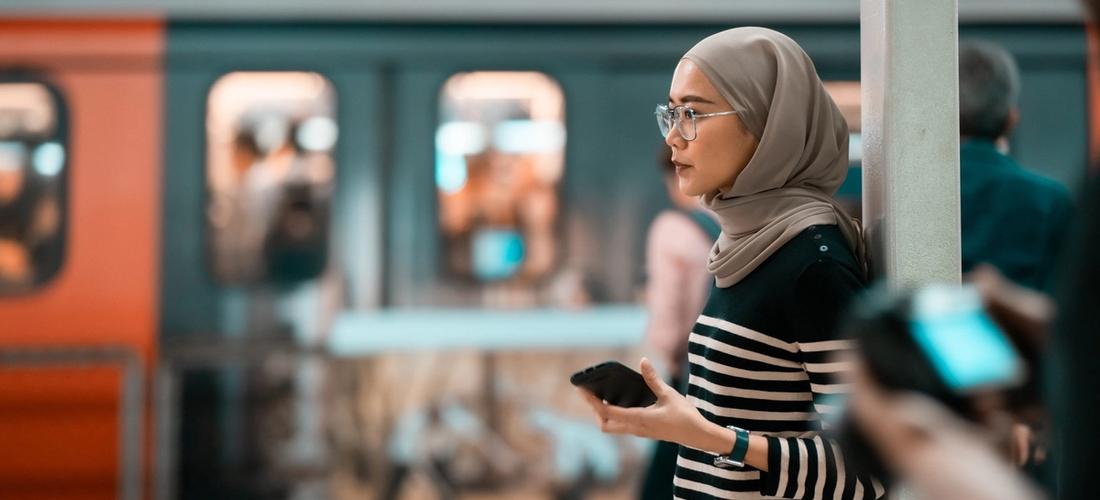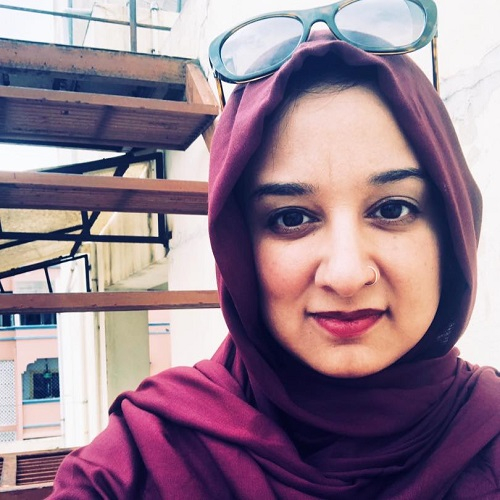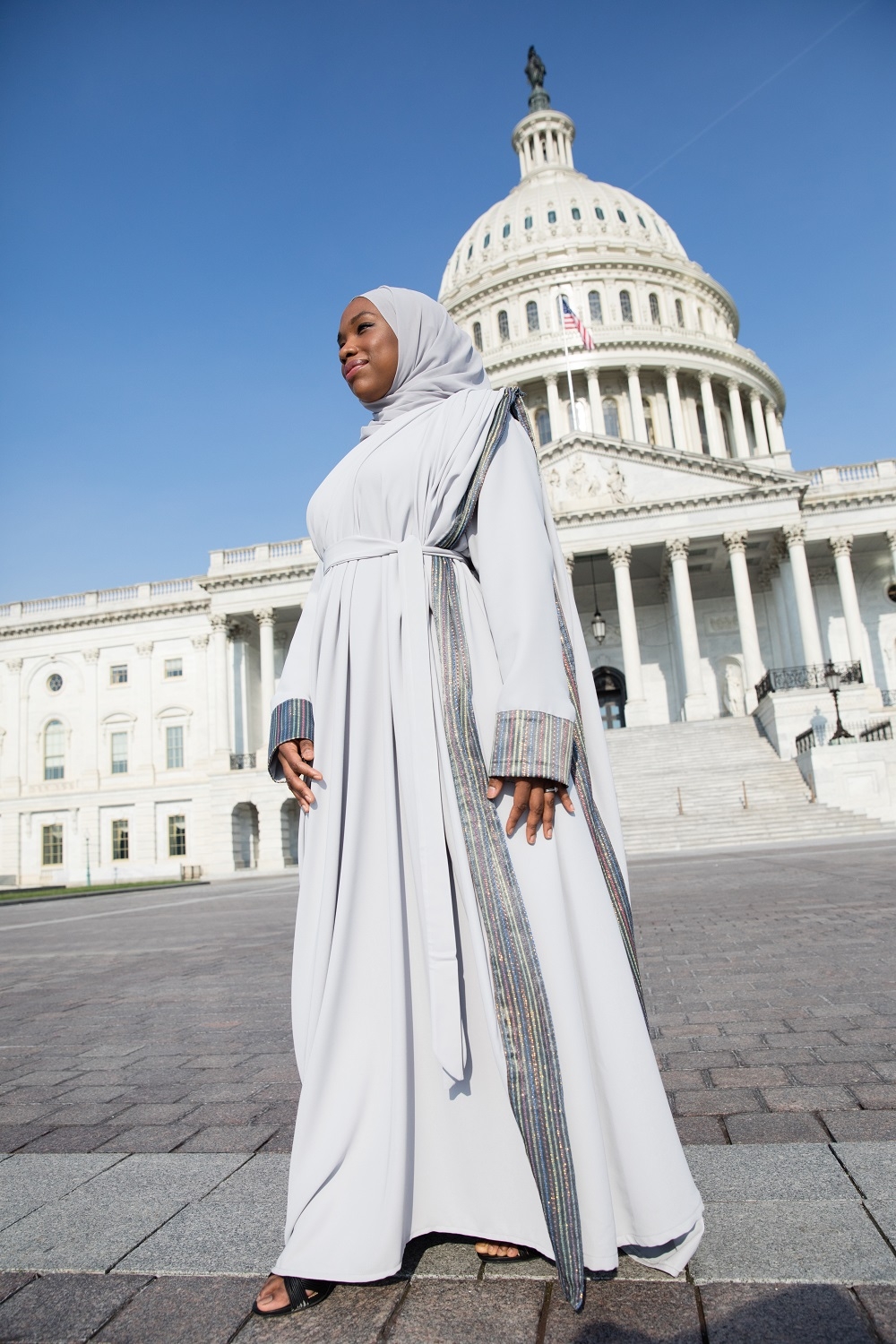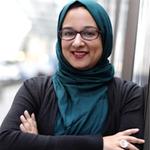Have Hijab, Will Travel – On Living Visibly Muslim & When it's a Choice and When It's Not
Faith
|
Sep 30, 2021
|
6 MIN READ

A Muslim woman traveling; image source: BuzzFeed on Pinterest
This article is part of a special series exploring our stories as visibly Muslim women in the last two post-9/11 decades.
“Have hijab, will travel. Do you remember that?” she asked me.
I laughed “Sure do,” I replied, remembering she had jokingly said that to me when I had made my first trip to New York after she had hired me to be the new Islam editor for Beliefnet, a multifaith religion news site, in 2005.
My former editor and I sat in a hotel bar in the after hours of the 2018 Religion Newswriters Association convention we were both at, catching up after years of not seeing each other. After she had hired me in 2005, I spent four wonderful years on the religion and Islam beat, which has been continued to be my journalistic area of expertise for more than two decades now.
We sat that night and reminisced about a lot of things, including the origin of that phrase (have hijab, will travel) my former boss had uttered to me several times in friendship and humor over the years. Four years post 9/11, when I had been hired by Beliefnet (and less than a year after I had started wearing hijab), the general feeling of “kumbaya” and trying not to vilify the whole of Islam and Muslims terrorists engaged in violence was starting to wear thin.
The London bombings would come soon after I had joined Beliefnet, followed by other domestic and international mass shootings, bombings and terrorists attacks – perpetuated by so-called Muslims, White Nationalists and other groups. Each time our Muslim communities braced for three things: an inevitable backlash, an issuing of condemnations, and an utterly different set of verbiage, outrage and justification if the perpetrators were white or not Muslim.
“Have hijab, will travel,” became a sort of reluctant mantra thrust upon me, and also in a way on so many others who were living their lives and practicing their faith entirely separate from those who perpetrated acts of violence and mangled the teachings of our faith.

The author on a visit to (pre-COVID) India.
I’ve lived nearly half of my life not wearing hijab (but engaging in modest dressing) and wearing it, give or take a few years. I was obviously and identifiably Muslim without my hijab by how I looked and how I lived my life (the only girl wearing sweatpants in gym class instead of the standard shorts, spending Ramadans in the counselor’s office or library instead of the cafeteria, not partaking in the drinking scene in college and on and on). I then became VERY visible when I started wearing hijab.
But honestly, I never gave it much thought outside of a few incidents when I did feel fear, frustration or anger at how I was perceived or treated for what I knew was the visibility of my hijab and my Muslim-ness. A bike rider once yelled “F**k you,” at me as my 13-year-old daughter and I were walking to our car after I had picked her up from an art class. Another time I was headed to a birthday party at my autistic son’s therapist’s home – she lived in a more rural area of Central Virginia – and the plethora of Trump signs coupled with the dirty looks and middle finger raised to me from a man in a car next to mine at a stoplight had me gripping the steering wheel a little tighter.
And yeah, the multiple stops at airports and being separated from my family and taken into another room for extra checking because I was on some sort of watchlist. Many of us share these stories. I’m sure – given my easy-going, Pollyanna-ish nature – that I missed many more microaggressions towards me over the years.
It’s important to note that our choice to be visible as Muslim women in the United States, whether we wear the hijab or not, shouldn’t always juxtaposed against the Islamophobic or anti-Muslim incidents we face. Sometimes I feel that by continuously talking about this takes away from all the different parts of our Muslim-ness and the visibility that comes with it. But, this is very much a part of our Muslim lives. I hope, if you’ve been reading the stories we’ve brought to you about post-9/11 living in the past two decades, that you’ve been able to find yourself in some part of these shared experiences.

A Muslim woman praying in public; photographer is Sana Ullah.
Those of who choose to be visible as Muslims (and it's not always a choice) – through our hijabs, through our actions and our lives – do so for a variety of reasons. Exploring these reasons and helping women share their stories has been one of the most rewarding and weighty experiences of my life. This month alone in our series focusing on living visibly Muslim in the two decades since 9/11, we’ve brought the following stories to you:
1. Our Haute Hijab blog writer Layla Abdullah-Poulos wrote about why she doesn’t shed tears on 9/11 and how “this is not about dismissing one collective trauma for another. This is about recognizing how national mourning tends to happen around certain things rather than others, and how various communities’ trauma are too often ignored or given little importance.”
2. I wrote about why we are doing this series, and how “We've learned that it's on us to push forth our stories, to work through our inter- and intra-cultural and religious issues, to acknowledge and tackle our own racial, political and social problems beyond how non-Muslims want to box and view us.”
3. Dr. Uzma Jafri of the Mommying While Muslim podcast wrote about (and offered tips) the challenges of parenting children in post 9/11 times.
4. HH blog writer Nargis Rahman shared her own experiences of living as visibly Muslim the past two decades and what keeps her dedicated to living this way.

Shereen Kassir
5. Guest contributor Shereen Kassir spoke about how, as an Australian thousands of miles away from Ground Zero, she faced anti-Muslim harassment as a university student.
6. HH blog writer Danah Shuli shared tips for how to pray in public safely.
7. HH Marketing Manager Noor Suleiman simply and passionately wrote about why she chooses to be visible, and why it’s so very worth it to her.
8. HH blog writer Hakeemah Cummings shared how she has never considered removing her hijab, writing that “As a Black woman, there is no removing my skin color to make the world see me differently; as a Muslim woman I see my hijab in a similar way.”

HH's Hakeemah Cummings
9. Guest contributor and New Yorker Shay N. talked about how she took back control from her fear in the years following 9/11 (with her husband being a police officer and a part of the rescue efforts).
10. Nargis also interviewed CAIR’s Zahra Billoo and Muslim Anti-Racism Collaborative’s Namira Anani Islam about what makes for a good ally in these contensious times.
11. And finally, guest contributor Monira Uddin shared her 9/11 story and how she is hopeful that the undercurrent of love among neighbors of different religions and cultures will help carry us through.
Producing a series like this makes me grateful for the convictions and strengths of Muslim women living in their own communities around the U.S. and in the world. My reporting and editing in this Muslim beat often leaves me personally exhausted and worried for the state of humanity and our ummah. While there is no neat bow we can tie on this package – because frankly, life is always messy, complicated and, well, a test – there are extraordinary lives being lived all around us. That we get to share a small part of that with you is a profound gift.
Indeed, the words of Surah Ar-Rahman always come back to me: “Fabi ayyi ala i rabbikuma tukaththiban.” What favors of your Lord would you deny?
Insha’Allah, none of them.
Subscribe to be the first to know about new product releases, styling ideas and more.
What products are you interested in?

